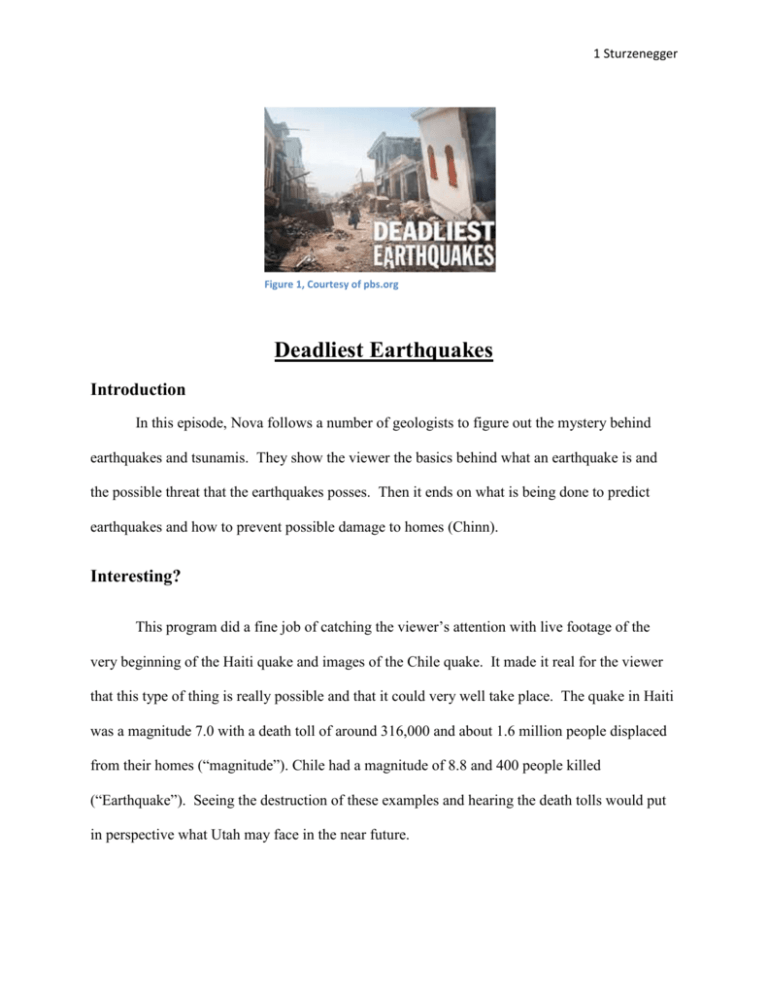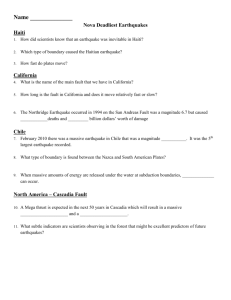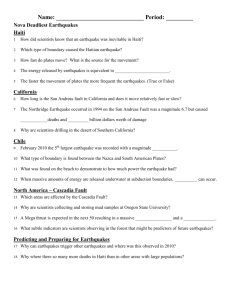Review 2 - Matts Portfolio
advertisement

1 Sturzenegger Figure 1, Courtesy of pbs.org Deadliest Earthquakes Introduction In this episode, Nova follows a number of geologists to figure out the mystery behind earthquakes and tsunamis. They show the viewer the basics behind what an earthquake is and the possible threat that the earthquakes posses. Then it ends on what is being done to predict earthquakes and how to prevent possible damage to homes (Chinn). Interesting? This program did a fine job of catching the viewer’s attention with live footage of the very beginning of the Haiti quake and images of the Chile quake. It made it real for the viewer that this type of thing is really possible and that it could very well take place. The quake in Haiti was a magnitude 7.0 with a death toll of around 316,000 and about 1.6 million people displaced from their homes (“magnitude”). Chile had a magnitude of 8.8 and 400 people killed (“Earthquake”). Seeing the destruction of these examples and hearing the death tolls would put in perspective what Utah may face in the near future. 2 Nova takes the viewer to Haiti, Chile and other parts of the world to show the viewer what kind of damage these earthquakes dealt to each area. For someone with limited knowledge of what an earthquake is and how it’s formed this movie is an easy watch. Although people need to have some sort of interest in this movie or it may be more useful to put you to sleep. The main reason is because the subject of earthquakes can be told in a very short amount of time. This documentary dragged out basic knowledge on the basics of earthquakes. It may be a snore to watch throughout but it does grab your attention in the beginning. The reason it doesn’t keep your attention is because it repeats a lot of information that is told throughout the documentary Towards the beginning of this program it tells you what causes earthquakes and attempts to explain that scientists can’t predict earthquakes. They explained that we can place sensors near a fault line and monitor the faults activity but it didn’t say that the tension build up is located in different regions of an active fault line. The only problem there was with this information, is it didn’t go into depth why we couldn’t predict earthquakes. You kind of have to make your own assumption of why that is. Also, that these specific areas have very rough ridges that combine with other ridges of the neighboring fault and could give at any particular moment (Chinn). Basically we can’t see the faults underground ridges; therefore we can’t predict what type of pressure is needed for that area to give. 3 Relatable? Later in this program it told the viewer where most of the loss of life came from. This should have been told at the beginning while discussing the quakes in Chile, California, and Haiti. Each had differences in loss of life. For example, it mentioned in 1994 in Northridge Figure 2, live footage in Haiti after a devestating earthquake courtesey of pbs.org California earthquake had a loss of life of only 57 people. The other startling figure is California’s earthquake magnitude was a 6.7 (Irvine). When you compare the two figures from Haiti, one would only assume that with a .3 difference in magnitude that the loss of life would be a little more significant. There should have been more discussion on what factors lead to death while discussing these statistics. For example, I think they should have talked about the quality of the buildings that one area had over another. If you were trying to watch this to compare what may happen to someone living in area like Utah, then it’s a great reference; however there are some areas that need to be concerned. For example the concentrations of Utah’s population that live on the fault line are in the 90% 4 range. Along with this figure the loss of life is predicted to be 7,600 people and 18 billion dollars in damage (USSC). These figures do compare with the Haiti and California quakes but the concentration of civilians and the quality of structures differ greatly. I enjoyed how this program showed the viewer different earthquakes, their destructive power, and what scientists are doing to overcome these issues. The only problem I had with this is that it left the viewer more concerned with that the quakes destructive power. What I mean is the program would show one of these three areas and show all the problems that occur with an earthquake but would never give the viewer the peace of mind that there is something being done to prevent damages until the end of the movie. It was great to see at the end of this program that Nova showed that there were other ways to prepare for earthquakes. Whenever you learn about an issue like this some programs tell you what the issue is but never leave you with some semblance. They bring up that in California there are changes to building codes to make each building more resistant to earthquakes. They are making these codes requirements for all building (Chinn). This way every citizen can have peace of mind that they can be safe. Nova does a great job of leaving towards the end what some promising advances may help earthquake prone areas. Conclusion In the end this program has some flaws but is very informative of earthquakes and how their created. It gives the viewer much information to take in and process. This film does have relevance to people in Utah. This movie shouldn’t be taken out of context and if learning about Utah’s big earthquake, one needs to learn more about Utah and what variables affect the damage and death toll here. 5 Works Cited Chinn, Peter, Dir.Deadliest Earthquakes. Prod. Yavar Abbas. Nova. 16 December 2010. Film "Earthquake in Chile - The Big Picture." Boston.com. N.p., 2010. Web. 26 Mar 2012. Irvine, T. "Northridge Earthquake1994." Northridge 1994. N.p., Web. 26 Mar 2012. "Magnitude 7.0 - HAITI REGION Earthquake Summary." Usgs science for a changing world. United States Geological Survey, 2012. Web. 26 Mar 2012. “Utah seismic safety commission”.Utah State, 2009. Web. 26 Mar 2012








